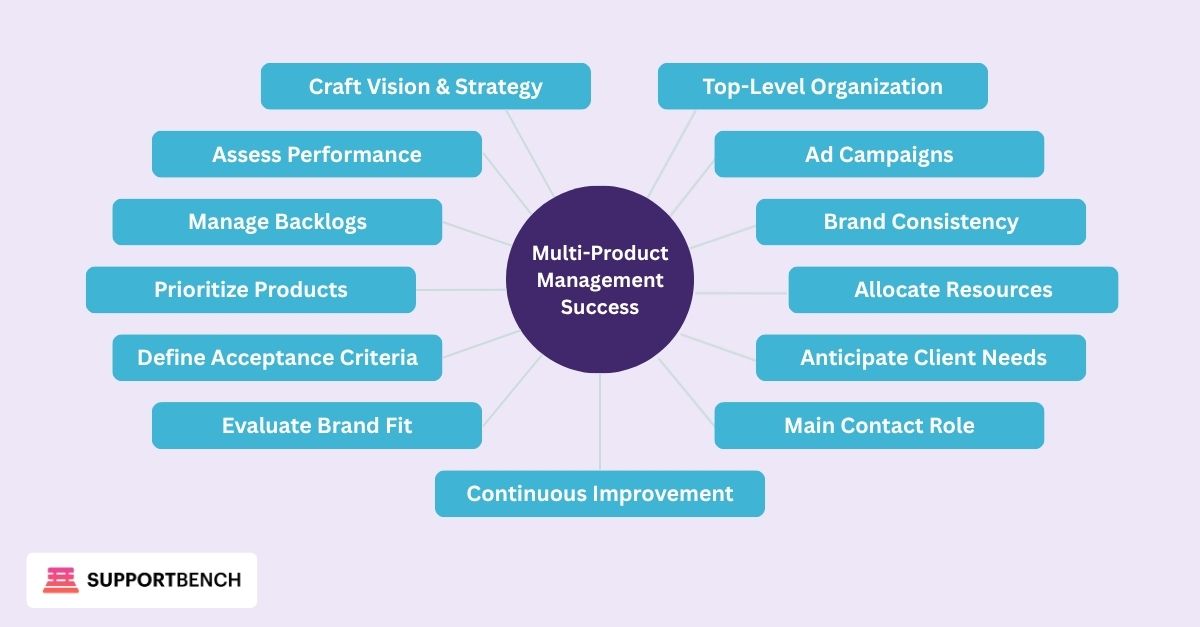An increasing number of companies are offering multiple products to consumers, with each product managed and monitored in its own way. While some businesses successfully navigate the complexities of managing a range of products, others face challenges in handling multiple brands effectively.
Let’s review some important steps companies can take to improve the management of their product portfolio and better control the sale of multiple products to consumers.
At a Glance:
Managing multiple products requires aligning each product under a cohesive vision, regularly evaluating performance, and prioritizing resources based on strategic goals. Effective multi-product management drives growth, improves efficiency, and ensures resources are allocated to products with the highest potential.
Top Strategies for Multiple Product Management
Managing a portfolio of diverse products requires focused strategies to ensure they complement each other and contribute to overall business success. Here are key strategies for managing multiple products effectively:
Strategy #1 – Craft a Product Vision and Strategy
Align each product in your portfolio under a cohesive vision. This unified vision ensures that development, marketing, and sales efforts are working toward a common goal. A well-crafted product strategy establishes clear objectives, success metrics, and a roadmap, providing clarity across teams.
This strategic approach is essential for keeping your portfolio aligned with business goals and customer needs.
Strategy #2 – Assess Your Product Performance
Regular evaluation of each product’s performance is essential to understanding its strengths and areas for improvement. Use key performance metrics like revenue, market share, and customer satisfaction (CSAT).
Tools such as the BCG Matrix or Product Lifecycle help in assessing how each product is performing in the market and guide resource allocation effectively.
Strategy #3 – Manage Multiple Product Backlogs
Each product in your portfolio should have its own distinct backlog, prioritized based on business goals and customer needs. Maintaining separate but interconnected backlogs for each product helps ensure development efforts align with market demands and customer expectations.
This organized approach improves communication across teams and ensures the most impactful features are developed first.
Strategy #4 – Distinguish and Prioritize Between Products
Not all products are equal. Prioritize products based on their potential for market success, profitability, and strategic importance to the business. By distinguishing between products aimed at different market segments, you can avoid brand confusion and guarantee that resources are dedicated to the most promising products.
Strategy #5 – Define Acceptance Criteria
Set clear, measurable acceptance criteria for each product. These criteria define what success looks like and guide product development to meet both customer expectations and business objectives. Clear criteria also facilitate testing and quality assurance, ensuring consistency across your product portfolio.
Strategy #6 – Be Honest About What Brands Will Work Best
Understand which brands or products will resonate with your target market. If a product aligns well with your existing brand, leverage that reputation to drive customer interest. However, for products that may not fit the core brand, it’s worth considering whether a new brand identity or separate product line is needed to better serve the target audience.
Strategy #7 – Ensure Effective and Top-Level Organization
As your portfolio grows, it’s crucial to have a well-structured team in place. Assign product managers or owners to oversee the development, marketing, and feedback of each product. An effective organizational structure ensures that all products are managed in a coordinated way, allowing the business to adapt quickly to market changes.
Strategy #8 – Create Strong Ad Campaigns for Each Product
Each product requires tailored marketing efforts to attract its specific customer base. Invest in targeted ad campaigns that highlight each product’s unique features and benefits. Effective ad campaigns not only differentiate products but also build their identity, driving customer interest and increasing sales.
Strategy #9 – Ensure Consistency with the Brand’s Core Identity
Maintaining brand consistency across your product portfolio is crucial. Regardless of the diversity in products, they should all align with the company’s core values, visual identity, and messaging. Consistent branding helps build customer trust and ensures your products resonate with the audience while reinforcing your company’s overarching vision.
Strategy #10 – Prioritize and Allocate Resources
Allocate resources effectively based on the strategic importance of each product. Balance investments between core products that drive revenue, growth products that show potential, and exploratory products that are experimental or under development. This approach ensures that resources are used efficiently across your entire portfolio.
➤ With Supportbench’s reporting dashboards, businesses can see which products generate the highest customer impact and allocate resources accordingly, avoiding waste and strengthening ROI.
Strategy #11 – Anticipate Client Needs
Proactively understanding and anticipating customer needs is vital for staying competitive. Use customer feedback, market research, and data analysis to stay ahead of trends and ensure your products meet or exceed expectations. This foresight enhances customer satisfaction and loyalty across your portfolio.
Strategy #12 – Act as the Main Contact
Make sure that there is a clear point of contact for each product, whether it’s a product manager or a dedicated team. This central point of communication guarantees that all aspects of the product, from development to customer relations, are managed efficiently. Effective communication among teams helps keep the product aligned with its goals.
Strategy #13 – Learn and Improve Continuously
Continuous learning and improvement are at the core of successful product management. Regularly gather feedback, assess performance, and adjust your strategies as needed. By adopting a mindset of continuous improvement, businesses can refine their products and techniques to better meet customer needs and business objectives.
Case Studies: How Leading Companies Manage Multiple Products
To better understand how effective multi-product management works in practice, let’s explore how two industry leaders, Apple and Procter & Gamble, manage their diverse product portfolios.
Apple’s Product Portfolio
Apple has successfully managed a broad range of products, such as the iPhone, MacBook, and Apple Watch, by ensuring each product maintains its own identity while aligning with the company’s overarching brand.
Each product serves a unique market segment but follows the same design philosophy and high-quality standards, strengthening brand loyalty and consumer trust.
Procter & Gamble’s Approach
Procter & Gamble manages multiple consumer goods products under different brand names, each with distinct marketing and growth strategies.
This approach allows P&G to tap into various market segments while tailoring strategies to suit specific customer needs, demonstrating how effective multi-product management can drive growth across different industries.
Conclusion
Managing multiple products within a business is challenging, but with the right strategies in place, companies can drive growth and improve customer satisfaction. By aligning products under a cohesive vision, assessing their performance, and ensuring effective resource allocation, businesses can maximize the success of their product portfolio.
Supportbench offers tools that can help businesses manage a diverse portfolio. With workflow automation and AI-driven insights, companies can improve communication, streamline processes, and provide a better customer experience.
Book a demo today to discover how Supportbench can help you manage your product portfolio more efficiently.















